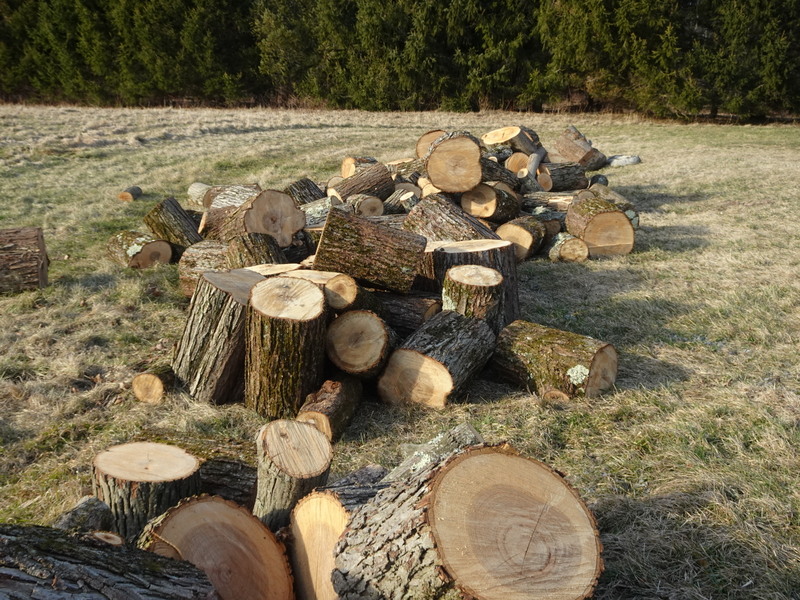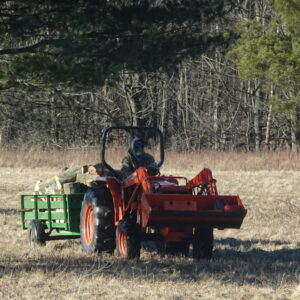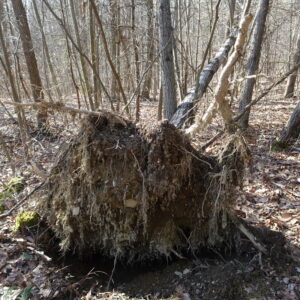After the Storm

 “I lost big trees in the recent wind,” I tell the Finger Lakes Land Trust steward who answers my call. “A mature oak, a sugar maple, a big hickory, and a few red maples. Many ash are broken and badly wounded and they’re already struggling to survive. A few big white pines broke off at the roots and lie on the forest floor plus at least half a dozen aspen.” She listens quietly. I imagine she’s heard similar reports all week.
“I lost big trees in the recent wind,” I tell the Finger Lakes Land Trust steward who answers my call. “A mature oak, a sugar maple, a big hickory, and a few red maples. Many ash are broken and badly wounded and they’re already struggling to survive. A few big white pines broke off at the roots and lie on the forest floor plus at least half a dozen aspen.” She listens quietly. I imagine she’s heard similar reports all week.
 “Matt who tends my forest and my son Anthony cleaned up the fallen trees and cut the broken pieces,” I say. “They’ll be firewood for next winter, but it hurts to see old trees uprooted.”
“Matt who tends my forest and my son Anthony cleaned up the fallen trees and cut the broken pieces,” I say. “They’ll be firewood for next winter, but it hurts to see old trees uprooted.”
“Yes, it hurts,” she agrees with a gentle voice. I can tell she cares.
The ground didn’t freeze this unusually warm winter, so the trees weren’t firmly anchored in the earth like they are most winters. In the wettest parts of the forest some couldn’t withstand the fierce wind.
 “We’ve seen lots of this,” she finally said. I realize how attached I am to each tree and how I want to save all of them, hundreds of them, especially the old trees. I realize I can’t.
“We’ve seen lots of this,” she finally said. I realize how attached I am to each tree and how I want to save all of them, hundreds of them, especially the old trees. I realize I can’t.
During the storm, as the wind howled, I was bedridden with a fierce respiratory virus. For a few nights, there wasn’t enough air in all the world to stop me from gasping for my next breath. I could only try to relax into my tight breath and sip more water. Occasionally, I took a puff from my inhaler when air hunger felt overwhelming, but that didn’t help much.
Do the oaks and maples resist when the wind pushes them to the earth or breaks their branches? Or do they relax into their fate?
 As I gasped, I knew it would be a blessing to die in my warm bed at the age of 78. I thought of people being bombed, starving people, crying cold children. I felt fortunate and protected by my home and community. This would be a good way to die—just sink toward the ground like a huge oak tree and let the earth cradle me.
As I gasped, I knew it would be a blessing to die in my warm bed at the age of 78. I thought of people being bombed, starving people, crying cold children. I felt fortunate and protected by my home and community. This would be a good way to die—just sink toward the ground like a huge oak tree and let the earth cradle me.
***
Have you had weather damage where you live? Floods, fires, or winds? How do you respond to it? It’s happening in so many places, but I hope the new openings in my forest canopy will provide light and space for young trees to thrive.
For other posts about my land, see My Hector Home: Protecting the Forests of the Finger Lakes. Or Give Thanks for the Teaching of Trees.



March 21, 2024 at 1:14 pm
Lin Gregory
I’m so sorry to hear you lost so many trees Elaine – that must have been heart-breaking to see them down… and such magnificent species among them with a sugar maple and an oak. It’s often the trees that are more isolated or on the edge of woods that suffer the most in these storms – which mirrors the fact that we all need community to keep us standing and strong…including your own need for support during the worst of your illness. Thankfully it sounds as though you are back on your feet and out walking the paths, albeit a little more slowly, just as the season of renewal awakens.
One question – do you leave any of the fallen trees in place to feed the soil or are all of the logs cleared away? Over here we see more and more fallen trees left where they fell to provide nutrients for the soil and occasionally places for new seedlings to grow.
March 22, 2024 at 12:33 pm
Elaine Mansfield
Thanks, Lin. Only a few of the logs were cleared away. We left most trees right where they fell. Some were left leaning against larger trees and they’ll eventually fall in another wind. Since I burn firewood for heat (with an efficient stove + an air filter), some of the larger trees were split into firewood to dry for future winters–but it wasn’t many trees in the end. For trees like pines, the branches were cut enough to drag off the trail to make homes for wildlife and eventually to rot into soil. The cut trees were ones that blocked major hiking trails. The forest looked like a mess after the storm and my helper is attached to every tree, but he’s a forester and left fallen branches and broken limbs to gather leaves and make new soil.
My lungs are still healing from the virus. It’s been a winter of mystery viruses and I’m not alone in having a persistent one. It will dissolve into memory when the cold surrenders to spring warmth, but there’s still a light covering of snow on the ground. The cold air is a challenge to breathe even with a mask or scarf. After a warm autumn and winter, we’re having an unusually harsh spring although the forecast is for the cold to ease a little next week. Still, I see more snow is expected tonight with a temperature of -4C. Off I go to heat water for another cup of herbal tea for the lungs. Enjoy your gorgeous walks. Mine have been too brief.
March 15, 2024 at 12:16 pm
Jean Raffa
I feel the same pain every time a tree falls or has to be cut down on our property or elsewhere. We lost many beautiful hemlocks to the wooly adelgid that plagued the North Caroline forests for several years. Although hemlocks don’t make for good firewood or furniture,(their wood is very twisty) our neighbor built us a beautiful 10 foot long dining table that still lives on our screened porch and has served us well for years. Last summer we lost a cherry tree and my brother-in-law, George, who carves wood as a hobby, made us a gorgeous bowl and candle holder out of it. Another neighbor cuts the rest of our fallen trees into firewood and always gives some of it to neighbors. Other smaller trees in the depth of the forest are allowed to decompose. It makes be feel better to know that at least we aren’t wasting fallen wood. However, what I worry about the most is that the loss of every tree is also a loss of healing oxygen to our atmosphere. Your recent struggle to breathe because of your respiratory virus reminds me that if the logging industry keeps cutting down trees, in a few generations everyone will be struggling to breathe.
March 17, 2024 at 3:44 pm
Elaine Mansfield
We’ve had a plague of wooly adelgid on the National Forest–no matter what the forest service does to try to stop it. Slowly, all the hemlocks are dying. The big grove is about 1/2 mile away where there’s a gully and protection from the fiercest winter winds. That’s where the hemlock are disappearing fast. My forest is spared because there are few hemlocks and no large ones. I am losing other trees, primarily ash, but as the climate warms, I fear this will only get worse, so we’re doing all we can with the help of the Finger Lakes Land Trust to protect my acres of mixed hardwood trees and pine. May Artemis teach us how to protect our forests while there’s still time. It’s easy to become depressed about our ecological situation, but that doesn’t help either.
I’m glad you have a new dining room table and a cherry bowl. Nothing is being wasted, but I also wonder about the changes in our atmosphere. My upper respiratory infection was not directly related to the logging industry which isn’t close to me because of logging restrictions on the National Forest land. On the other hand, we had fierce air pollution and orange skies from the Canadian wildfires last spring and who knows what that did to everyone’s lungs? We’ll breathe easy for now and honor the trees while we have them. Blessings to the Trees.
March 13, 2024 at 11:44 am
Michael Cooper
Thanks, Elaine, for your beautiful contemplation. What a richly real and imaginary world you inhabit with great inspiration!
Best Wishes to You and Your Family,
Michael
March 13, 2024 at 5:22 pm
Elaine Mansfield
Thank you, Michael. I’m forever grateful to Vic for having the foresight to see the beauty and possibilities of this land and forest. I visited the trees today and wished them well. Each one feels like a friend and part of my community. I appreciate having you as part of my human community. We’re all linked together.
March 13, 2024 at 7:53 am
Aladin Fazel
Dear Elaine, my answer to your question is yes! The people who died by bombs and rackets or the regimes who hung them because of their wish to live in freedom are still young and do not deserve their deaths. Like that old Oake, I am ready to give myself freely up to my fate. Although your Oake tree might also be a victim of climate change, who knows? Be safe and take care.
March 13, 2024 at 9:54 am
Elaine Mansfield
It’s horrifying what’s happening to people in Iran, Aladin. No one deserves what’s happening to these young innocents hoping for freedom.
There are other oak trees in my forest and many other trees, all struggling with climate change. We’re lost many species in the last fifty years. It’s another result of human selfishness and cruelty since we’ve known this would happen for a long time if we didn’t change our ways. It’s not as cruel as killing a young person wanting freedom, but in the end, it also destroys life. May you stay safe, too.
March 13, 2024 at 6:26 am
Lori McCray
May Artemis guard the forest.
March 13, 2024 at 9:39 am
Elaine Mansfield
She has so far along with the Finger Lakes Land Trust–but this is a new world with climate change. Hoping for the health of Nature in all her forms, including the human one.
March 12, 2024 at 8:20 pm
Marian Beaman
My heart aches as I read about the fallen trees in your area. I’m glad the Finger Lakes Land Trust steward understood your pain of losing those pillars of nature: mature oaks, a sugar maple, a big hickory, and a few red maples. Trees aren’t people, but I’m sure they felt like friends, as you strolled through the forest in days gone by.
I hope there are more sunshiny days ahead for you as your body gathers strength after a very stressful winter. I’ll pray for butterflies to work their magic when they arrive, Elaine!
March 13, 2024 at 9:46 am
Elaine Mansfield
The trees are my protectors and friends. Some are only good for firewood now and some (evergreens) will decompose and make soil. Nothing gets wasted in nature and I hope the holes in the canopy will provide opportunities for others. There are many trees still out in the forest. I’m still feeling weakened from the virus, but I don’t bounce back like I did a few decades ago. That’s normal and I’m learning more life cycles. The Monarch population may be greatly diminished this year since many were lost by bad weather in Mexico, but there may be many local butterflies such as Swallowtails. We will see. It only takes one fertile Monarch to lay hundreds of eggs, so it’s possible they will recover. Sending love to the land of sunshine.
March 16, 2024 at 3:50 pm
Marian Beaman
Thank you–and I join your in hope for Monarchs, Swallowtails–and more!
March 12, 2024 at 8:34 am
Deborah Gregory
Dear Elaine, I note the juxtaposition between the trees not being anchored in their earth bed and falling this winter and you being bedridden, gasping for breath in your wooden bed, once a living tree. And down you both go this winter. Relaxing into one’s fate by staying in bed sounded like the best approach, rather than weakly rise, stand tall and fight a virus that will ravish your body anyhow.
Hmm, floods, fires and winds are not so much happening outside, although it’s another cold and wet day here on the south coast, but rather inside. My hope is that what’s falling within is creating new openings for light, space and things to grow. Everything you’ve shared here today resonates deeply my dear friend, thank you. Sending love and light across the oceans and oaks between us, Deborah.
March 12, 2024 at 5:14 pm
Elaine Mansfield
That’s a hard connection to miss, Deborah. I lived unanchored for over a month. (My bed was my grandparent’s bed, I think carved from walnut, so it was a place of safety for me.) I took a slow walk in the sunshine today with a friend and Disco. There’s so much wild and destructive weather in the United States this spring. I hope the weather will settle down, but I don’t count on it. Today and tomorrow are sunny with relatively calm winds. Whew! I’m sure the trees are as relieved as I am. May Artemis guard the forest.
I love your good news about your book. We never know when life will offer a surprising gift. Sending you love with hope for more and more good book news and fields of flowers. Your writing about the Crone is sure to resonnate with many, including me.